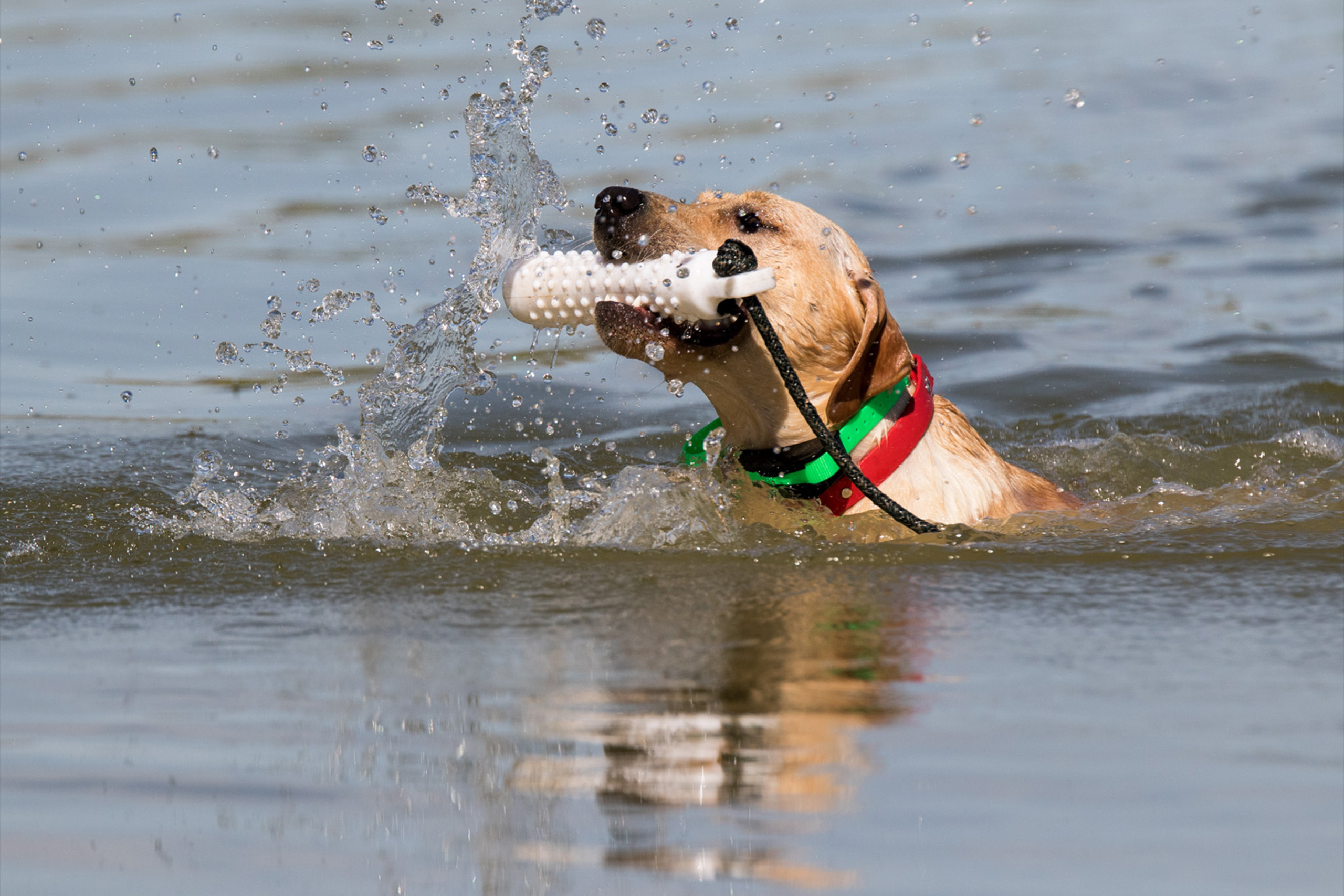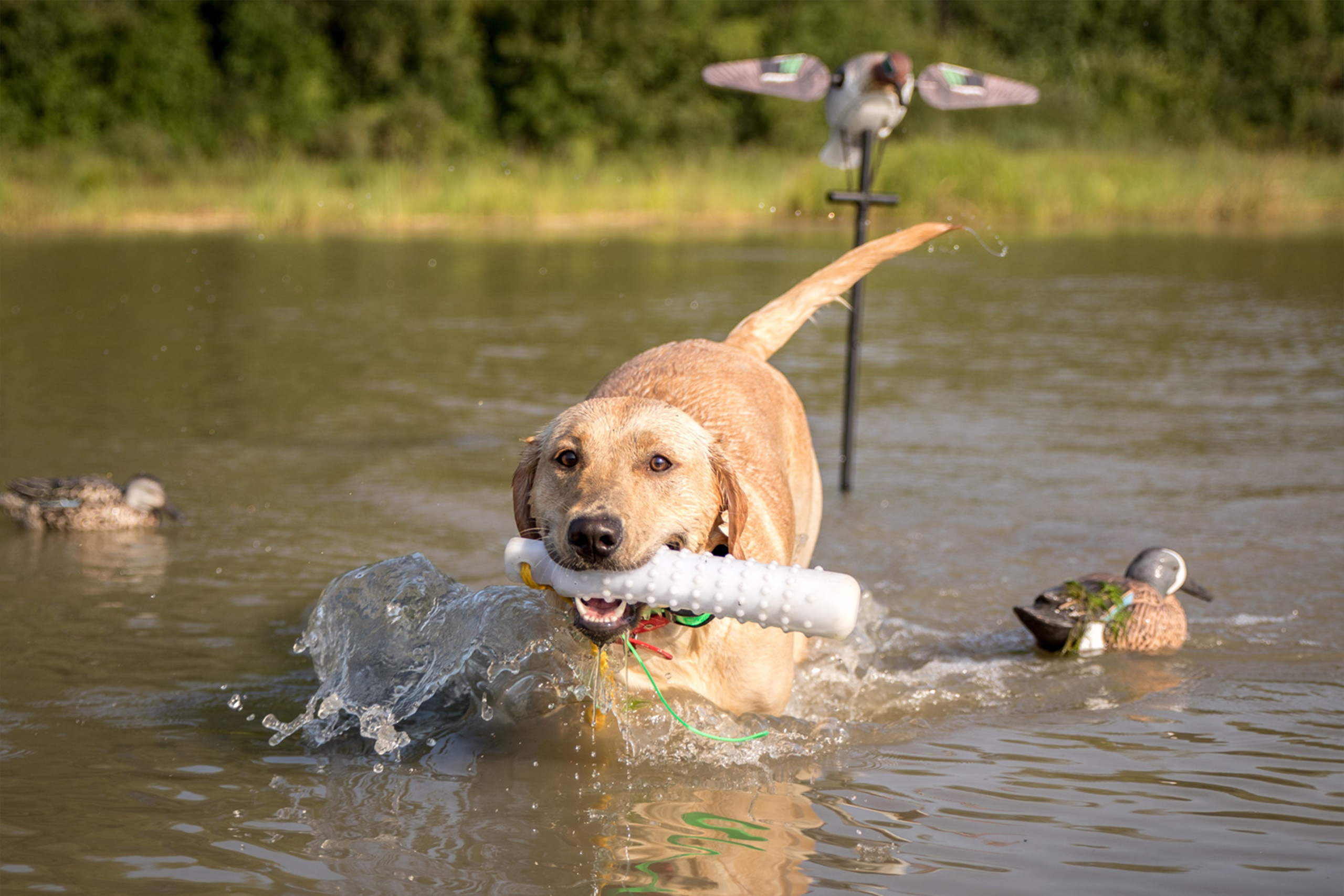Introducing Your Dog to Decoys: A Step-by-Step Guide
Posted by Lucky Duck Team on May 30th 2025
Train the Retrieve, Not the Rig: Why Decoy Introduction is Non-Negotiable
As the season gets closer, imagination can start to play through our next hunts: the sky is perfect, the birds are flying, and a beautiful flock of mallards commits to your spread. You call the shot, your duck folds up, and you send your eager retriever for the pickup. But instead of returning with the bird, your pride and joy triumphantly dashes back with… a decoy. (I bet that doesn’t happen in your imagination.) Or worse, your dog gets tangled in an anchor line, panicking and flaring every bird within a square mile.
Many hunters are left asking, "Why isn't he retrieving like he's supposed to? He does it perfectly in the backyard!" A good bet is that those dogs were never properly introduced to the more confusing environment of a real hunt. Decoys, calls, boats, and gunfire could all be new variables that can distract or frighten an untrained dog. The only way to avoid this is through training your pup.
This guide provides a step-by-step process to properly condition your retriever, transforming them from a backyard hero into a confident, steady, and reliable hunting partner. The goal is simple: make the decoys and other distractions so uninteresting that your dog’s focus remains in lockstep with yours and those ducks get retrieved. Depending on your dog, you may not need all these steps; judging that will be up to you as your pup’s trainer.
Solid Obedience is Everything
It’s worth noting before we get started that you can run through every specialized drill imaginable, but it will all be for nothing if your dog doesn’t have a rock-solid foundation in basic obedience. Before you even begin decoy work, your dog must be reliable with the "sit," "heel," "come," “no,” and "stay" commands. A dog that is under control and will be attentive to you when you require it is a dog that is ready to reach his full potential. This basic obedience is the foundation upon which all successful hunting performance is built.
Phase 1: The Foundation - Mastering Decoys on Dry Land
Before your dog ever gets its paws wet, all decoy work must begin on solid ground. This controlled environment allows you to build a solid foundation of understanding and confidence without the added variable of water.
Passive Introduction: Making Decoys Boring Before Training Begins
The easiest first step requires almost no effort. Simply place a handful of decoys in your yard where your dog spends time. Leave them out for days. By constantly seeing, smelling, and eventually ignoring them during daily activities, your dog will begin to view them as nothing more than uninteresting lawn ornaments. This passive exposure is a powerful way to reduce their curiosity before you get into formal drills or real hunts.
Teaching That Decoys Are Taboo
Once your dog is accustomed to the decoys' presence, it's time introduce a spread. Spread a dozen decoys across your lawn, place your dog on a leash, and simply walk him around the outer edge of the spread.
Slowly guide him through the decoys. Allow him to smell and investigate, but use a firm "no" or "leave it" command if he tries to mouth, paw at, or pick one up. The goal is for him to walk calmly through the spread without showing interest. This may take five minutes or it may take multiple sessions; your dog's uninterested attitude will tell you when you're ready to move on.
First Retrieves
With your dog calmly ignoring the decoys, you can begin retrieving drills. Start by tossing a fun bumper just beside the decoy spread, not in it. Praise your dog enthusiastically for each retrieve. Gradually, change your tosses so the dog must run past the decoys and then through a part of the spread to complete the retrieve.
Finally, begin tossing the bumper directly into the middle of the decoys. If at any point your dog stops to mess with a decoy, you can use the “leave it” or “no” command and walk out into the spread yourself, regain his focus with the bumper, and encourage him to complete the correct retrieve. This teaches him that the only object of value is the one you send him for.
Phase 2: Transitioning to Water Work
Once your dog is completely ignoring decoys on land, it’s time to get wet. The process is the same, but the new environment requires careful setup to ensure your dog’s confidence continues to grow.
Shallow Water and Short Anchor Lines
Your first water sessions should be in a location shallow enough for you to easily walk through. If your dog gets hesitant or spooked by bumping into a floating decoy, your ability to walk out and reassure him is important.
Critically, make sure your decoy anchor lines are as short as possible. A dog that gets tangled in a long decoy cord can develop a legitimate fear of decoys, and legitimate fear can be very difficult to remove.
Building Confidence in the Water
Just as you did on land, repeat the same gradual progression. Start with retrieves alongside the floating decoys. Move to making retrieves beyond the spread, and finally, toss the bumper directly into the middle of your floating rig. Bumping into the plastic birds is inevitable; reward each successful retrieve with enthusiasm to help communicate to your dog know that the decoys are harmless obstacles on the way to the real prize.
Phase 3: Simulating a Real Hunt
A dog that is steady around decoys is great, but a real hunt involves much more. Once the decoy work is solid, you should begin layering in the other sights and sounds of a hunt to create the full picture.
The Real Deal: Transitioning from Bumpers to Actual Birds
A dog that reliably retrieves bumpers may still be hesitant with a real duck. Once your training is advanced, introduce a cold, dead duck to the process. Let your dog get comfortable holding and letting you have it, then repeat some of the basic land and water retrieves.
Adding Sound: Integrating Duck Calls and Gunfire into Your Training
Your dog should never hear a duck call or a shotgun blast for the first time on opening day. That’s just asking for trouble, and you can expect it to be overwhelming for your dog also. During your training sessions, start blowing your duck call so the sound becomes a normal part of the background. For gunfire introduction, always prioritize safety and start slow.
Have a helper fire a low-recoil shotgun at a distance while holding your dog, then have your pup retrieve a dead bird or bumper. Over multiple sessions, gradually decrease the firing distance until you can shoot over a steady dog. The goal is to keep the sound of the gun from startling your dog and associate it with the positive excitement of a retrieve.
From the Boat to the Blind
If you hunt from a boat, a layout blind, or a dog stand, these are new environments that you should introduce your pup to. The best way to do this is on dry land first. Set up the boat or blind in your yard and work on basic obedience and retrieving drills in and around it. Once the dog is comfortable, you can move the setup to the water's edge and eventually to a full hunting scenario. By introducing each element of a real hunt, you avoid overwhelming your dog when it’s go-time.
From a Backyard Drill to a Proud Day in the Blind
The work you put in during the off-season is the investment that pays off on opening day. By methodically introducing your dog to the sights, sounds, and scenarios of a real hunt, you eliminate confusion and build a confident, reliable partner. You will have traded the frustration of retrieving decoys for the pride of watching your dog deliver a perfect bird to hand, ready for the next flight.
Protect Your Partner, Protect Your Investment
The journey from an over-eager, clumsy puppy to a polished retriever is one of dedication for both you and your pup. Now, ensure that your most valuable asset is safe and secure on every trip to and from the field.
The hunt doesn’t start when you set the last decoy; it starts the moment you load up at home. The Lucky Kennel is engineered to provide ultimate protection and peace of mind for the serious hunter. With a 5-Star Crash Test Rating, an extremely durable rotomolded design, and a locking paddle-latch door, it’s built to withstand the rigors of the road and the field. Strategic ventilation helps to keep your dog comfortable after a hard day’s work, helping them arrive home safe, rested, and ready for the next adventure.
Get your Lucky Duck Kennel today!




